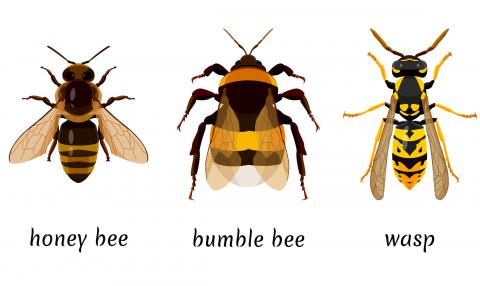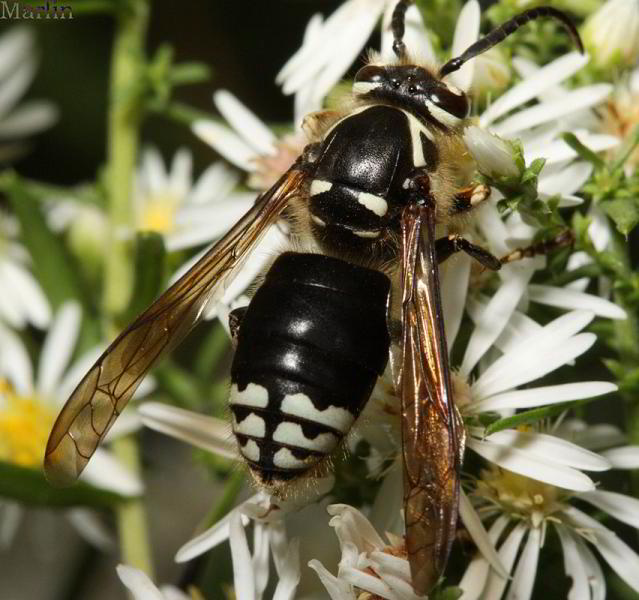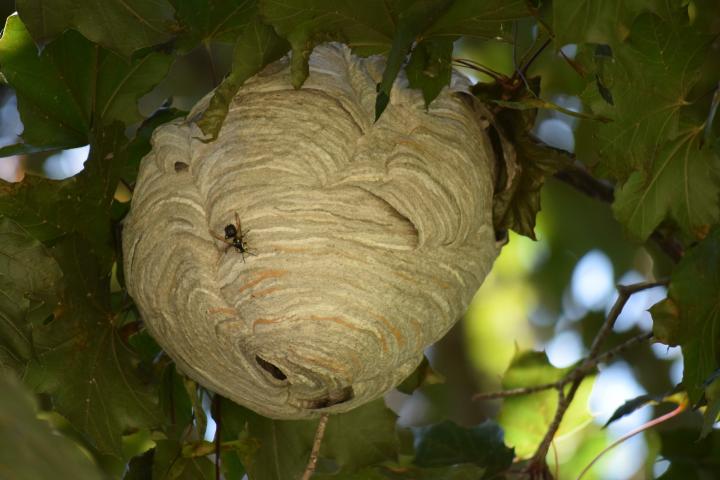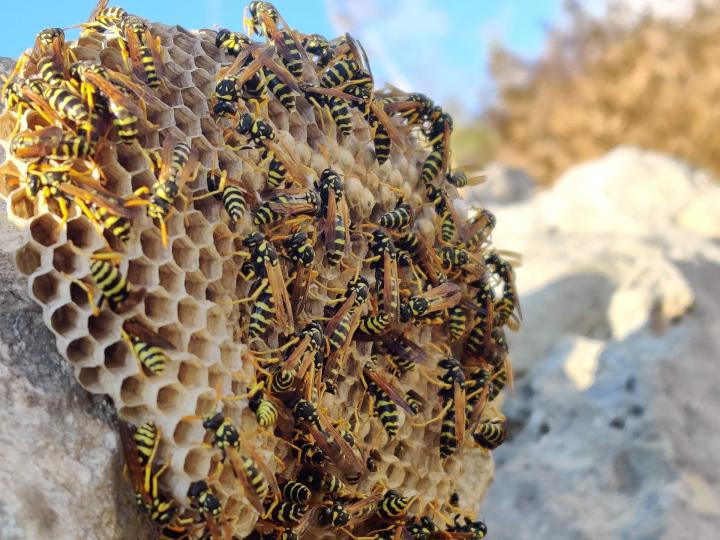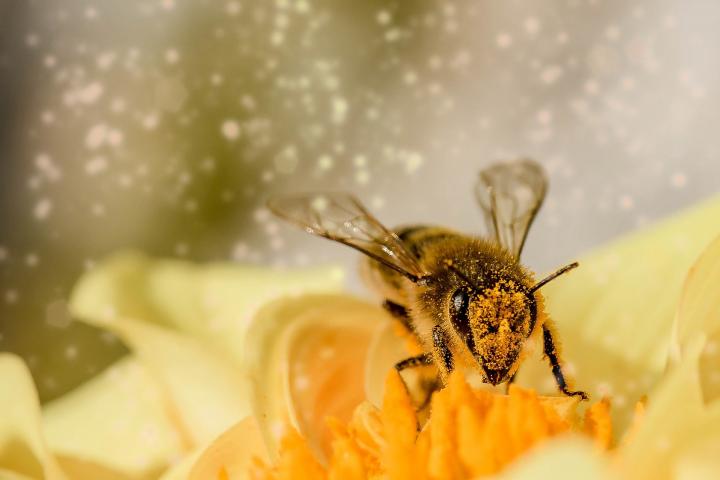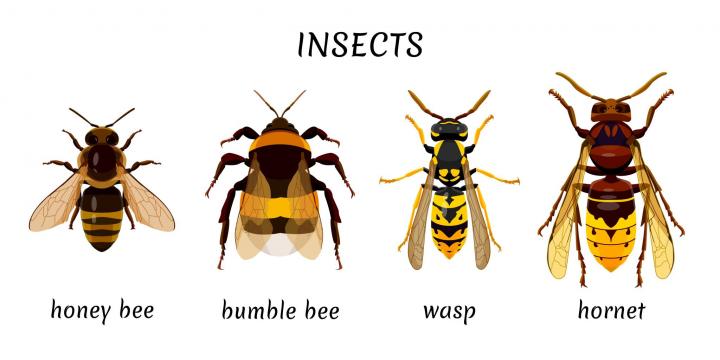Is A Hornet And A Wasp The Same Thing
Bees and wasps took separate evolutionary paths over 100,000,000 years ago. Bees are vegetarians, collecting pollen to feed their young, while wasps and hornets are carnivores, feeding on other insects. The main thing that they do have in common is that only females can sting.
What’s the Difference Between Wasps, Bees, and Hornets?
Hornets
All hornets are wasps, but not all wasps are hornets. In the U.S., we have no native hornets. Our main hornet is the European hornet which was introduced into New York in 1840. It looks like a large yellowjacket—about ¾ to 1½ inches long—and nests in the ground or in hollow trees.
The bald-faced hornet isn’t a hornet at all; it’s a type of paper wasp.
Another “hornet” we commonly encounter is the bald-faced hornet, a type of paper wasp closely related to the yellowjacket. They are black with white markings on their face and abdomen. You have probably seen their huge, gray, basketball-sized nests swinging high in a tree.
The bald-faced hornet constructs a huge papery nest every season.
A new hornet that was recently introduced to the west coast is getting a lot of press these days. The Asian giant hornet is also called the “murder hornet” for the way they attack honey bee colonies, killing the bees by ripping off their heads, eating the honey, and stealing the larva to feed to their own young. They are the giants of the wasp world, measuring 2 inches long. In Japan, they are called sparrow wasps since they resemble small birds in flight. Their sting is very painful to humans and about 50 unlucky people a year are killed by the deadly neurotoxin contained in their venom.
Wasps
Although there are many solitary wasps such as digger wasps and mud daubers, most wasps are considered social, meaning that they live in colonies with a queen, female worker bees, and drones, like honeybees. Solitary wasps nest in the ground or in natural cavities, while social wasps attach papery nests made from chewed fibers to tree limbs or the eaves of your house.
Honeycomb structure of a large, above-ground, paper wasp nest. Although they look like yellowjackets, they are not. Yellowjackets are much smaller.
The yellowjacket is a social wasp that will nest above or below ground. In the fall, all the social wasps die off—except for the fertilized queens. They overwinter in protected spots such as hollow logs, under loose tree bark, or in a soil cavity, and emerge in the spring to start a new colony. Solitary wasps depend on their larvae to mature in spring and start a new generation.
Are Hornets and Wasps Good or Bad?
Wasps are very important, playing a vital ecological role controlling pests. Social wasps are predators, collecting insects such as caterpillars, grubs, grasshoppers, aphids, and flies, which are stung, paralyzed, and put into the egg chambers for newly hatched larvae to eat. Wasps also prey upon spiders; the blue mud dauber’s preferred meal is the black widow!
Since wasps prey on some bad bugs, they should be considered beneficial to gardeners. Adults feed on nectar, doing some accidental pollinating at the same time, so they are minor pollinators.
On the other hand, they are drawn to meat and sweets, scavenging whatever they find, so they can be a nuisance for outdoor dining and will congregate around trash cans. If you encounter them, don’t swat at them or act in an aggressive manner or you risk being stung. They will also sting to protect their hive. If you should accidentally mow over a ground nest—run! Unlike honey bees who can only sting once, wasps are capable of stinging multiple times.
Bees
Bees eat pollen and nectar, feeding it to their young. This makes them important pollinators.
This hairy bee is covered with pollen.
Bees look furry because they are covered with branched, feather-like hairs that pollen clings onto. Bees are not aggressive and only sting in self defense. In fact, the males do much of the foraging and they have no stinger. With the exception of honey bees and bumblebees, most bees are solitary and live in underground nests. Each female takes care of her own eggs and gathers pollen to feed the larvae when they hatch. There are about 4,000 species of bees native to the US and Canada. (For more about them, see our Native Bees article)
Identifying at a Glance
- Bees have a wide, hairy body, have stout legs, and lose their stinger when they sting.
- Wasps and hornets have skinny bodies with narrow waists. Their bodies are mostly hairless and can sting multiple times.
Of course, there are many kinds of bees. Most of us grew up learning about the sophisticated social structures of honey bees and bumblebees, and we’ve come to think that their lifestyle represents all bee behavior. The truth is that the world is home to more than 20,000 species of bees, and a whopping 90% of them do not live together in hives.
Our native solitary bees—such as mason bees and leafcutter bees—which are most vital to our flowers and food. Learn more about these amazing heroes of pollination—and see how to bring these docile native bees to your garden.
Life Cycle
Whether bee, wasp, or hornet, the basic life cycle is the same—egg, larva, pre-pupa, pupa, adult. Fertilized eggs produce female bees, while unfertilized ones produce males. Eggs are placed in individual nest cells and provisioned with a food source for the newly hatched larvae to eat—a loaf made of pollen and nectar for bees or a paralyzed insect for wasps.
Some eggs hatch in a few days, while others wait until next season to emerge. The larvae eat, grow, and molt their skin up to 5 times. The pre-pupal stage can last a long time. An egg laid in the spring can take all summer to reach the pre-pupal stage and then it can stay that way all fall and winter. Some bees remain pre-pupal for several years! The pupa looks like an adult, but is pale in color with no wings or hair. In a short time, it chews its way out of the nest as an adult.
Some wasp larvae in their hexagonal cells.
Wasps, Bees, and Hornets are Beneficial
Most bees, wasps, and hornets are beneficial. Both wasps and hornets are real workhorses for pest management in the garden and farm, feeding on the “bad” insects that destroy crops. In fact, if you were able to see many of their nests, they’re stocked with paralyzed adult grasshoppers, crickets, caterpillars, and sawflies.
Also, if you look carefully in the garden, wasps very helpful pollinators, too! They are usually solitary and non-aggressive, busily hovering and moving from flower to flower.
None of these beneficial insects should be killed unless their nest is close to humans and is creating a hazard. For example, we had bald-faced hornets make a nest next to our front door and every time the door opened or closed, they were ready to fight! Needless to say, that nest had to go. We waited until after dark when the bees had all returned to the nest and sprayed an aerosol wasp killer into the entrance hole. After a few days of seeing no activity, we were able to remove the nest.
For ground-nesting wasps and hornets, locate the entrance hole, spray into the opening, and plug the hole with a large rock. Don’t try to burn or drown a nest with water. That just makes them mad! When attempting any eradication of nests, be sure to dress appropriately, covering your eyes and all bare skin (just in case). Also be sure to have an escape route planned!
Otherwise, pause before you kill these insects; remember that they are a beneficial part of our ecosystem and especially critical for pest control in our gardens, public lands, and croplands.
Is A Hornet And A Wasp The Same Thing
Many of us use the words hornet and wasp interchangeably, but that’s a vast overgeneralization that does a disservice to these winged creatures. Understanding the differences between hornets and wasps might help you to make better pest control decisions, prevent you from killing beneficial species, and of course, maybe keep you from getting a painful sting.
Here’s the biggest thing to know: All hornets are wasps, but not all wasps are hornets.
Hornet or Wasp?
“Hornets are just a kind of wasp,” says Jason Gibbs, assistant professor of entomology at the University of Manitoba in an email interview. “Wasp is a very broad term that covers many different species with different lifestyles.”
There are more than 100,000 wasp species on Earth, each a testament to the startling diversity in these winged bugs. They’re found in every part of the world except polar areas. It’s usually easy to identify them, as they most often have black and yellow stripes, a well-defined and narrow waist, and a tapered abdomen.
List Of Is A Hornet And A Wasp The Same Thing
- ELIMINATE WASPS – Our exclusive VisiLure technology lures wasps, red wasps, mud daubers, and carpenter bees with appealing colors and a multi-dimensional pattern. Once attracted, they become stuck to the sticky surface and expire.
- NO KILLING AGENT – The targeted insects are naturally lured to the trap without odors, chemicals, or wasp sprays. It catches queens and workers, from spring through fall.
- PROTECT WILDLIFE – This TrapStik has been redesigned with bird guards to provide protection for birds, bats, and other small animals. Avoid hanging where birds or other wildlife activity happens.
- PREVENT DAMAGE – Mud daubers (mud wasps, dirt daubers) and carpenter bees can cause serious property damage. Our TrapStik can stop this before it starts, without the use of potentially harmful sprays or chemicals.
- MADE IN THE USA – At RESCUE!, our goal is to design, manufacture, and market the safest and most effective pest control solutions available for homeowners. We are proud to manufacture our products in the USA!
Additional Info :
| Color | Green |
| Item Dimensions | |
| Height | 11.5 Inches |
| Width | 7.5 Inches |
| Length | 7.5 Inches |
- FOR RESCUE! WHY TRAP – This refill works with the RESCUE! WHY Non-Toxic Reusable Trap for Wasp, Hornet and Yellowjackets, and provides 2 weeks of attractant power.
- WHAT IT CATCHES – This attractant lures paper wasps, red wasps, bald-faced hornets, European hornets, and yellowjackets. The two-week supply includes three attractants that work together inside the trap.
- NO KILLING AGENT – Unlike potentially harmful sprays and chemicals, the WHY Trap and its attractant rely on a non-toxic mode of action, killing insects naturally.
- WHERE TO USE – For best results, use the WHY Trap outdoors, at least 20 feet away from where you want to enjoy outdoor activities.
- MADE IN THE USA – At RESCUE!, our goal is to design, manufacture, and market the safest and most effective pest control solutions available for homeowners. We are proud to manufacture our products in the USA!
Additional Info :
| Item Dimensions | |
| Height | 12 Inches |
| Width | 5.25 Inches |
| Length | 7.25 Inches |
| Weight | 0.09 Pounds |
- Product Type :Lab Supply
- Package Dimensions :11.0″ L X8.5″ W X12.0″ H
- Country Of Origin :United States
- Package Weight :18.4Lbs
Additional Info :
| Item Dimensions | |
| Height | 11 Inches |
| Width | 2.63 Inches |
| Length | 2.63 Inches |
| Weight | 1.09 Pounds |
- This design features an abstract flying insect wasp, yellow-jacket, or hornet
- Lightweight, Classic fit, Double-needle sleeve and bottom hem
Additional Info :
| Color | Black |
- Delta Dust Bed Bug Insecticide – 1 lb.
- Yield: 1 lb. of Delta Dust covers about 2,000 sq.ft.
- Target Pest: Ants, Bed Bugs, Boxelder Bugs, Cockroaches, Crickets, Fleas, Firebrats, Silverfish, Termites, Carpenter Ants, Carpenter Bees, Centipedes, Ground Bettles, Millipedes, Scorpions, Spiders, Sowbugs, Wasps, Bees, Webbing, Clothes Moths, Carpet Beetles, Pantry Pest, Plant Pest, Slugs, and Ticks.
- Active Ingredient: Deltamethrin, 0.05%
- Cannot ship to NY or CT.
Additional Info :
| Item Dimensions | |
| Height | 9.63 Inches |
| Width | 1.9 Inches |
| Length | 3.8 Inches |
| Weight | 1 Pounds |
